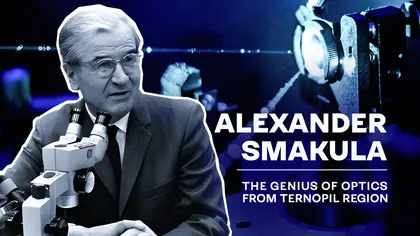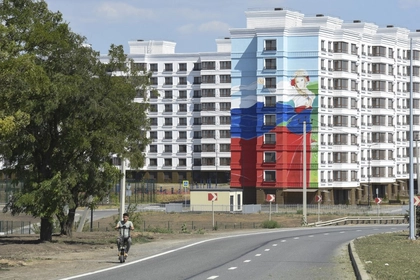Alexander Teodorovich Smakula was a physicist who made a significant contribution to the creation of piezoelectric materials, semiconductor structures, unique all-weather motor oils, night vision devices, and lasers. He was the author of the main optical invention of the 20th century: the method known as the “illumination of optics”.
Smakula created dozens of world-class inventions. There are even scientific terms that bear the name of this scientist from Ternopil: A “Smakula inversion”: the transformation of crystalline hydrocarbon by the electrical excitation of p-electrons.
The “Formula of Smakula”: a mathematical connection between the concentration of defects in a crystal, the wavelength it is irradiated with, and the color of said crystals after irradiation. Night vision devices (including thermal imaging) wouldn’t work without bromide iodide monocrystals, another invention of Smakula. Furthermore, let’s not forget about lithium fluoride and sodium fluoride, lubricants suitable for efficient use at both high and low temperatures, and lasers – Smakula worked with all these critical technologies.
But the enlightened optics creation have been the scientist’s main achievement. And we are not only talking about the hard glasses, but also about binoculars, spyglasses, microscopes, telescopes, periscopes, cameras, optical devices for weapons.
Apparently, many have heard about the advances in optics pioneered by Carl Zeiss, but almost no one, with the exception of a narrow-field of specialists, knows that by the early 1930s the refinement of this technique slowed down. Even the best of engineers thought that optics technology had gone as far as it could go. To explain the problem simply: they believed that it was impossible to make lenses any better because of the laws of chemistry and physics.
Was it a dead end? For several years it seemed to be. It was not until 1935 that Smakula’s discovery was recognized by the scientific community as the “foremost invention of the 20th century in the field of optics.” This “Smakula effect” significantly improved the properties of lenses. Smakula came up with this revolutionary method by blazing a bold path away from traditional methods. He showed that if you cover the surface of a lens with a special film layer of a certain material that reduces the wavelength of light passing through it by 1/4, it will not only reduce the reflection of light, but also increase the contrast of the light that passes through the lens. The method was called the “illumination of optics”.
Smakula’s invention was registered in Germany (1935), where the scientist was then living (at the end of World War II he, along with a number of other German scientists and engineers, was taken to the USA). However, given military considerations, the “illumination of optics” method was kept as a German military secret for more than a year.

IMF Approves $1.1 Billion Loan Disbursement to Ukraine Before Trump Inauguration
When it was officially patented, it turned out to be the first optical patent in the world. To this day, the “Smakula method” remains standard technology in the manufacture of many cameras, optical devices, and weapons. In 1964, when the scientist became director of the single-crystal physics laboratory at the Massachusetts Institute of Technology (MIT), his colleague Professor Robert Fano, whom they still call “the revolutionary of computer science”, expressed his opinion about the scientific talent of this Ukrainian: “Alexander Smakula is a genius, a man who knows about materials like semiconductors, materials used in electronics.”
INTERESTING FACTS
• While studying at the University of Göttingen, this talented student was forced to work at salt mines and farms in order not to struggle for money. He also made a living by tutoring.
• From a letter by Alexander Smakula to the mathematical scientist Alexander Levitsky: “I have to print my works in German journals, because they are accessible to researchers, not only by the German people, but also by everyone else. Do not get angry at me about this, please, I will place my works in the “Notes of the Shevchenko Scientific Society.”
• In Smakula’s Doctor of Philosophy diploma his origin was indicated as “Dobrovody, Galicia”.
• The scientist’s niece Anna Dmytryshyna related: “He used to go to the forest very often just to talk with it.”
• Smakula’s Monograph: “Monocrystals: Growing, Manufacturing and Application” (1962) is still used in universities in many countries as a textbook on practical crystallography.
• Smakula is the only Ukrainian to have become a full professor at the Massachusetts Institute of Technology.
• Smakula actively participated in Ukrainian Diaspora’s activities in the USA. In his home in America he furnished a special separate room dedicated to Ukraine: he kept a collection of Ukrainian books, embroidery, and souvenirs there.
• From a letter by Alexander Smakula to his relatives: “I have been wandering abroad for over forty years, but I have not forgotten my Ukraine and will never forget it. I often look through Kobzar (a book of poems by Ukrainian poet and painter Taras Shevchenko).
• Smakula’s dream to see Ukraine again came true in 1972. He participated in an international crystallography conference held in Yerevan (Armenia), and then visited Kyiv, Ternopil, and his native Dobrovody. It was his first and last visit to Ukraine after the Second World War.
• The scientist’s biographers claim that when Smakula was greeted at the Kyiv airport by a scientific delegation, including members of the KGB and Communist Party representatives, the scientist said: “Guys, let me have a walk on my land on foot. – And most of all I want to taste Ukrainian borsch, which my mother used to cook.”
• UNESCO announced a year 2000 the year of Smakula.
• Peter, one of Smakula’s five children, was a famous American musician, a banjo virtuoso. (He died in 2008). His son Bob (the grandson of the scientist) also plays banjo and has a business repairing violins, guitars, mandolins.
FROM THE DOSSIER OF ALEXANDER SMAKULA:
• Alexandr Smakula was born on September 9, 1900 in Dobrovody, Ternopil region.
• He graduated from the Ternopil Gymnasium (secondary school). In 1918-1919 he fought in the Ukrainian Galician army. After the Bolsheviks came to power, he moved to Germany (1927), where he graduated from the University of Göttingen.
• He worked as a teaching assistant at the University of Göttingen (1930), as a lecturer at the University of Odesa (1928), as the head of the optical laboratory of the Institute for Medical Research in Heidelberg, as the head of one of the research laboratories of the Carl Zeiss Institute of Technology (1934), and at the Massachusetts Institute of Technology (1951).
• He was the founder and first head of the Massachusetts Institute of Technology’s Crystal Physics Laboratory, and an Honorary Member of the Optical Society and the Society of Ukrainian Engineers (USA).
• He died on May 17, 1983 in Auburn, Massachusetts.
• There is a monument dedicated to him in Dobrovody.
«For more than forty years, I have wondered through foreign lands, but I have not forgotten my homeland and will never forget it. I see it even in the lenses that I work with every day» - Alexandr Smakula.
JOIN US ON TELEGRAM
Follow our coverage of the war on the @Kyivpost_official.
This article by Nadiia Avramchuk and Mykola Sukhomozsky is reprinted with the publisher's permission from the book (UN)Celebrated Ukrainians Who Changed the Course of History, SAMIT-KNYHA, Kyiv, 2020.
You can also highlight the text and press Ctrl + Enter






